Resumen
Este estudio busca indagar la poética de la transitoriedad desplegada de Inert Gas Series/Helium, Neon, Argon, Krypton, Xenon/From a Measured Volume to Indefinite Expansion (Serie de gases inertes / Helio, neón, argón, criptón, xenón / De un volumen medido a una expansión indefinida), de Robert Barry (1969). Esta obra consistió en la liberación de gases desde sus contenedores a la atmósfera en diversos lugares de California, la cual fue anunciada por medio de un cartel blanco en el que se publicaron los datos de una dirección de correos y un número de teléfono, al que respondía una máquina contestadora con la grabación de su descripción. Con lo anterior, se pone en obra una dimensión temporal que se debate entre la fugacidad del gesto performático y la infinitud de lo que implica conceptualmente, que problematiza la inmaterialidad y que desplaza los valores plásticos a valores implícitos en la idea de obra como un ejercicio conceptual. Pero ¿qué implica la desmaterialización total del soporte de obra?, ¿qué es lo que intenta mostrar Serie de gases inertes mediante la alusión al tiempo? y ¿qué importancia tiene el arte, en tanto conceptual, para articular una idea de magnitud en la obra? Esta investigación busca responder a tales cuestionamientos desde la premisa de que la obra de Barry, como propuesta inmaterial, temporal y conceptual, logra presentar una serie de paradojas en torno al arte que articulan una poética de la transitoriedad, la cual es puesta a prueba mediante la comparación con otros ejemplos de obra (Rachel Whiteread, Oscar Muñoz y Olafur Eliasson). Finalmente, la poética de la transitoriedad exhibe la imposibilidad de retener el transcurso temporal mediante dispositivos plásticos que se proponen como un flujo, esto es, representan el cambio espacial/material en el tiempo.
Bergson, Henri. 1972. El pensamiento y lo moviente. Buenos Aires: Pléyade.
Eliasson, Olafur. 2011. Model for a Timeless Garden. Londres: Hayward Gallery.
Kant, Immanuel. 2006. Crítica de la razón pura. Madrid: Taurus.
Morgan, Robert C. 2003. El arte de la idea. Madrid: Akal.
MoMA (Museum of Modern Art). 2004. Collection Highlights. Nueva York: The Museum of Modern Art.
MoMa (Museum of Modern Art). 2019. “Robert Barry”. Consultado: 10 de noviembre de 2019. https://www.moma.org/collection/works/109710?locale=en
Muñoz, Oscar. 2006. Línea del destino. Zúrich: Daros Latinoamérica Collection.
Nancy, Jean-Luc. 2003. La partición de las artes. Valencia: Universidad Politécnica de Valencia.
Ricoeur, Paul. 1999. La lectura del tiempo pasado: memoria y olvido. Madrid: Arrecife.
Roca, José Ignacio. 2011. “Protografías”. En Oscar Muñoz: Protografías.Bogotá: Banco de la República. Consultado: 10 de noviembre de 2019. https://www.banrepcultural.org/oscar-munoz/

Esta obra está bajo una licencia internacional Creative Commons Atribución 4.0.
Derechos de autor 2020 Sandra Elisa Molina Franjola



